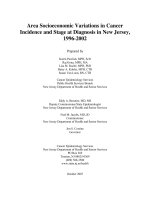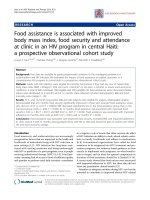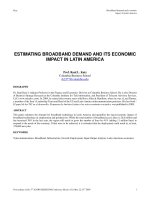Demand and Supply at Work in Labor Markets
Bạn đang xem bản rút gọn của tài liệu. Xem và tải ngay bản đầy đủ của tài liệu tại đây (528.94 KB, 15 trang )
Demand and Supply at Work in Labor Markets
Demand and Supply at Work
in Labor Markets
By:
OpenStaxCollege
Markets for labor have demand and supply curves, just like markets for goods. The law
of demand applies in labor markets this way: A higher salary or wage—that is, a higher
price in the labor market—leads to a decrease in the quantity of labor demanded by
employers, while a lower salary or wage leads to an increase in the quantity of labor
demanded. The law of supply functions in labor markets, too: A higher price for labor
leads to a higher quantity of labor supplied; a lower price leads to a lower quantity
supplied.
Equilibrium in the Labor Market
In 2008, about 35,000 nurses worked in the Minneapolis–St. Paul, Minnesota,
metropolitan area, according to the Minnesota Nurses Association. They worked for
a variety of employers: hospitals, doctors’ offices, schools, health clinics, and nursing
homes. [link] illustrates how demand and supply determine equilibrium in this labor
market. The demand and supply schedules in [link] list the quantity supplied and
quantity demanded of nurses at different salaries.
1/15
Demand and Supply at Work in Labor Markets
Labor Market Example: Demand and Supply for Nurses in Minneapolis–St. Paul
The demand curve (D) of those employers who want to hire nurses intersects with the supply
curve (S) of those who are qualified and willing to work as nurses at the equilibrium point (E).
The equilibrium salary is $70,000 and the equilibrium quantity is 35,000 nurses. At an aboveequilibrium salary of $75,000, quantity supplied increases to 38,000, but the quantity of nurses
demanded at the higher pay declines to 33,000. At this above-equilibrium salary, an excess
supply or surplus of nurses would exist. At a below-equilibrium salary of $60,000, quantity
supplied declines to 27,000, while the quantity demanded at the lower wage increases to 40,000
nurses. At this below-equilibrium salary, excess demand or a surplus exists.
Demand and Supply of Nurses in Minneapolis-St. Paul
Annual Salary Quantity Demanded Quantity Supplied
$55,000
45,000
20,000
$60,000
40,000
27,000
$65,000
37,000
31,000
$70,000
35,000
35,000
$75,000
33,000
38,000
$80,000
32,000
41,000
The horizontal axis shows the quantity of nurses hired. In this example, labor is
measured by number of workers, but another common way to measure the quantity of
labor is by the number of hours worked. The vertical axis shows the price for nurses’
labor—that is, how much they are paid. In the real world, this “price” would be total
labor compensation: salary plus benefits. It is not obvious, but benefits are a significant
part (as high as 30 percent) of labor compensation. In this example, the price of labor is
2/15
Demand and Supply at Work in Labor Markets
measured by salary on an annual basis, although in other cases the price of labor could
be measured by monthly or weekly pay, or even the wage paid per hour. As the salary
for nurses rises, the quantity demanded will fall. Some hospitals and nursing homes may
cut back on the number of nurses they hire, or they may lay off some of their existing
nurses, rather than pay them higher salaries. Employers who face higher nurses’ salaries
may also try to replace some nursing functions by investing in physical equipment, like
computer monitoring and diagnostic systems to monitor patients, or by using lower-paid
health care aides to reduce the number of nurses they need.
As the salary for nurses rises, the quantity supplied will rise. If nurses’ salaries in
Minneapolis–St. Paul are higher than in other cities, more nurses will move to
Minneapolis–St. Paul to find jobs, more people will be willing to train as nurses, and
those currently trained as nurses will be more likely to pursue nursing as a full-time job.
In other words, there will be more nurses looking for jobs in the Twin Cities.
At equilibrium, the quantity supplied and the quantity demanded are equal. Thus, every
employer who wants to hire a nurse at this equilibrium wage can find a willing worker,
and every nurse who wants to work at this equilibrium salary can find a job. In [link],
the supply curve (S) and demand curve (D) intersect at the equilibrium point (E). The
equilibrium quantity of nurses in the Minneapolis–St. Paul area is 35,000, and the
equilibrium salary is $70,000 per year. This example simplifies the nursing market by
focusing on the “average” nurse. In reality, of course, the market for nurses is actually
made up of many smaller markets, like markets for nurses with varying degrees of
experience and credentials. Many markets contain closely related products that differ in
quality; for instance, even a simple product like gasoline comes in regular, premium, and
super-premium, each with a different price. Even in such cases, discussing the average
price of gasoline, like the average salary for nurses, can still be useful because it reflects
what is happening in most of the submarkets.
When the price of labor is not at the equilibrium, economic incentives tend to move
salaries toward the equilibrium. For example, if salaries for nurses in Minneapolis–St.
Paul were above the equilibrium at $75,000 per year, then 38,000 people want to work
as nurses, but employers want to hire only 33,000 nurses. At that above-equilibrium
salary, excess supply or a surplus results. In a situation of excess supply in the labor
market, with many applicants for every job opening, employers will have an incentive
to offer lower wages than they otherwise would have. Nurses’ salary will move down
toward equilibrium.
In contrast, if the salary is below the equilibrium at, say, $60,000 per year, then a
situation of excess demand or a shortage arises. In this case, employers encouraged by
the relatively lower wage want to hire 40,000 nurses, but only 27,000 individuals want
to work as nurses at that salary in Minneapolis–St. Paul. In response to the shortage,
some employers will offer higher pay to attract the nurses. Other employers will have to
3/15
Demand and Supply at Work in Labor Markets
match the higher pay to keep their own employees. The higher salaries will encourage
more nurses to train or work in Minneapolis–St. Paul. Again, price and quantity in the
labor market will move toward equilibrium.
Shifts in Labor Demand
The demand curve for labor shows the quantity of labor employers wish to hire at
any given salary or wage rate, under the ceteris paribus assumption. A change in the
wage or salary will result in a change in the quantity demanded of labor. If the wage
rate increases, employers will want to hire fewer employees. The quantity of labor
demanded will decrease, and there will be a movement upward along the demand curve.
If the wages and salaries decrease, employers are more likely to hire a greater number
of workers. The quantity of labor demanded will increase, resulting in a downward
movement along the demand curve.
Shifts in the demand curve for labor occur for many reasons. One key reason is that the
demand for labor is based on the demand for the good or service that is being produced.
For example, the more new automobiles consumers demand, the greater the number
of workers automakers will need to hire. Therefore the demand for labor is called a
“derived demand.” Here are some examples of derived demand for labor:
• The demand for chefs is dependent on the demand for restaurant meals.
• The demand for pharmacists is dependent on the demand for prescription drugs.
• The demand for attorneys is dependent on the demand for legal services.
As the demand for the goods and services increases, the demand for labor will increase,
or shift to the right, to meet employers’ production requirements. As the demand for the
goods and services decreases, the demand for labor will decrease, or shift to the left.
[link] shows that in addition to the derived demand for labor, demand can also increase
or decrease (shift) in response to several factors.
Factors That Can Shift Demand
Factors
Results
When the demand for the good produced (output) increases, both the
Demand for
output price and profitability increase. As a result, producers demand
Output
more labor to ramp up production.
Education
and
Training
A well-trained and educated workforce causes an increase in the
demand for that labor by employers. Increased levels of productivity
within the workforce will cause the demand for labor to shift to the
right. If the workforce is not well-trained or educated, employers will
not hire from within that labor pool, since they will need to spend a
4/15
Demand and Supply at Work in Labor Markets
Factors
Results
significant amount of time and money training that workforce. Demand
for such will shift to the left.
Technology changes can act as either substitutes for or complements to
labor. When technology acts as a substitute, it replaces the need for the
number of workers an employer needs to hire. For example, word
processing decreased the number of typists needed in the workplace.
This shifted the demand curve for typists left. An increase in the
availability of certain technologies may increase the demand for labor.
Technology that acts as a complement to labor will increase the
Technology demand for certain types of labor, resulting in a rightward shift of the
demand curve. For example, the increased use of word processing and
other software has increased the demand for information technology
professionals who can resolve software and hardware issues related to a
firm’s network. More and better technology will increase demand for
skilled workers who know how to use technology to enhance
workplace productivity. Those workers who do not adapt to changes in
technology will experience a decrease in demand.
Number of
Companies
An increase in the number of companies producing a given product
will increase the demand for labor resulting in a shift to the right. A
decrease in the number of companies producing a given product will
decrease the demand for labor resulting in a shift to the left.
Complying with government regulations can increase or decrease the
demand for labor at any given wage. In the healthcare industry,
Government government rules may require that nurses be hired to carry out certain
Regulations medical procedures. This will increase the demand for nurses. Lesstrained healthcare workers would be prohibited from carrying out these
procedures, and the demand for these workers will shift to the left.
Labor is not the only input into the production process. For example, a
salesperson at a call center needs a telephone and a computer terminal
to enter data and record sales. The demand for salespersons at the call
center will increase if the number of telephones and computer terminals
Price and
available increases. This will cause a rightward shift of the demand
Availability curve. As the amount of inputs increases, the demand for labor will
of Other
increase. If the terminal or the telephones malfunction, then the
Inputs
demand for that labor force will decrease. As the quantity of other
inputs decreases, the demand for labor will decrease. Similarly, if
prices of other inputs fall, production will become more profitable and
suppliers will demand more labor to increase production. The opposite
is also true. Higher input prices lower demand for labor
5/15
Demand and Supply at Work in Labor Markets
Click here to read more about “Trends and Challenges for Work in the 21st Century.”
Shifts in Labor Supply
The supply of labor is upward-sloping and adheres to the law of supply: The higher
the price, the greater the quantity supplied and the lower the price, the less quantity
supplied. The supply curve models the tradeoff between supplying labor into the market
or using time in leisure activities at every given price level. The higher the wage, the
more labor is willing to work and forego leisure activities. [link] lists some of the factors
that will cause the supply to increase or decrease.
Factors that Can Shift Supply
Factors
Results
Number of
Workers
An increased number of workers will cause the supply curve to shift to
the right. An increased number of workers can be due to several
factors, such as immigration, increasing population, an aging
population, and changing demographics. Policies that encourage
immigration will increase the supply of labor, and vice versa.
Population grows when birth rates exceed death rates; this eventually
increases supply of labor when the former reach working age. An aging
and therefore retiring population will decrease the supply of labor.
Another example of changing demographics is more women working
outside of the home, which increases the supply of labor.
Required
Education
The more required education, the lower the supply. There is a lower
supply of PhD mathematicians than of high school mathematics
teachers; there is a lower supply of cardiologists than of primary care
physicians; and there is a lower supply of physicians than of nurses.
Government policies can also affect the supply of labor for jobs. On the
one hand, the government may support rules that set high qualifications
Government for certain jobs: academic training, certificates or licenses, or
Policies
experience. When these qualifications are made tougher, the number of
qualified workers will decrease at any given wage. On the other hand,
the government may also subsidize training or even reduce the required
6/15
Demand and Supply at Work in Labor Markets
Factors
Results
level of qualifications. For example, government might offer subsidies
for nursing schools or nursing students. Such provisions would shift the
supply curve of nurses to the right. In addition, government policies
that change the relative desirability of working versus not working also
affect the labor supply. These include unemployment benefits,
maternity leave, child care benefits and welfare policy. For example,
child care benefits may increase the labor supply of working mothers.
Long term unemployment benefits may discourage job searching for
unemployed workers. All these policies must therefore be carefully
designed to minimize any negative labor supply effects.
A change in salary will lead to a movement along labor demand or labor supply curves,
but it will not shift those curves. However, other events like those outlined here will
cause either the demand or the supply of labor to shift, and thus will move the labor
market to a new equilibrium salary and quantity.
Technology and Wage Inequality: The Four-Step Process
Economic events can change the equilibrium salary (or wage) and quantity of labor.
Consider how the wave of new information technologies, like computer and
telecommunications networks, has affected low-skill and high-skill workers in the U.S.
economy. From the perspective of employers who demand labor, these new
technologies are often a substitute for low-skill laborers like file clerks who used
to keep file cabinets full of paper records of transactions. However, the same new
technologies are a complement to high-skill workers like managers, who benefit from
the technological advances by being able to monitor more information, communicate
more easily, and juggle a wider array of responsibilities. So, how will the new
technologies affect the wages of high-skill and low-skill workers? For this question,
the four-step process of analyzing how shifts in supply or demand affect a market
(introduced in Demand and Supply) works in this way:
Step 1. What did the markets for low-skill labor and high-skill labor look like before
the arrival of the new technologies? In [link] (a) and [link] (b), S0 is the original supply
curve for labor and D0 is the original demand curve for labor in each market. In each
graph, the original point of equilibrium, E0, occurs at the price W0 and the quantity Q0.
7/15
Demand and Supply at Work in Labor Markets
Technology and Wages: Applying Demand and Supply
(a) The demand for low-skill labor shifts to the left when technology can do the job previously
done by these workers. (b) New technologies can also increase the demand for high-skill labor in
fields such as information technology and network administration.
Step 2. Does the new technology affect the supply of labor from households or the
demand for labor from firms? The technology change described here affects demand for
labor by firms that hire workers.
Step 3. Will the new technology increase or decrease demand? Based on the description
earlier, as the substitute for low-skill labor becomes available, demand for low-skill
labor will shift to the left, from D0 to D1. As the technology complement for high-skill
labor becomes cheaper, demand for high-skill labor will shift to the right, from D0 to
D1.
Step 4. The new equilibrium for low-skill labor, shown as point E1 with price W1 and
quantity Q1, has a lower wage and quantity hired than the original equilibrium, E0. The
new equilibrium for high-skill labor, shown as point E1 with price W1 and quantity Q1,
has a higher wage and quantity hired than the original equilibrium (E0).
So, the demand and supply model predicts that the new computer and communications
technologies will raise the pay of high-skill workers but reduce the pay of low-skill
workers. Indeed, from the 1970s to the mid-2000s, the wage gap widened between
high-skill and low-skill labor. According to the National Center for Education Statistics,
in 1980, for example, a college graduate earned about 30% more than a high school
graduate with comparable job experience, but by 2008, a college graduate earned
8/15
Demand and Supply at Work in Labor Markets
about 70% more than an otherwise comparable high school graduate. Many economists
believe that the trend toward greater wage inequality across the U.S. economy was
primarily caused by the new technologies.
Visit this website to read about ten tech skills that have lost relevance in today’s
workforce.
Price Floors in the Labor Market: Living Wages and Minimum Wages
In contrast to goods and services markets, price ceilings are rare in labor markets,
because rules that prevent people from earning income are not politically popular. There
is one exception: sometimes limits are proposed on the high incomes of top business
executives.
The labor market, however, presents some prominent examples of price floors, which
are often used as an attempt to increase the wages of low-paid workers. The U.S.
government sets a minimum wage, a price floor that makes it illegal for an employer
to pay employees less than a certain hourly rate. In mid-2009, the U.S. minimum wage
was raised to $7.25 per hour. As of mid-2013, there is a bill in the U.S. Congress to raise
the minimum wage to $10.15 per hour by 2015. Local political movements in a number
of U.S. cities have pushed for a higher minimum wage, which they call a living wage.
Promoters of living wage laws maintain that the minimum wage is too low to ensure a
reasonable standard of living. They base this conclusion on the calculation that, if you
work 40 hours a week at a minimum wage of $7.25 per hour for 50 weeks a year, your
annual income is $14,500, which is less than the official U.S. government definition of
what it means for a family to be in poverty. (A family with two adults earning minimum
wage and two young children will find it more cost efficient for one parent to provide
childcare while the other works for income. So the family income would be $14,500,
which is significantly lower than the federal poverty line for a family of four, which was
$22,811 in 2011.)
Supporters of the living wage argue that full-time workers should be assured a high
enough wage so that they can afford the essentials of life: food, clothing, shelter, and
healthcare. Since Baltimore passed the first living wage law in 1994, several dozen cities
enacted similar laws in the late 1990s and the 2000s. The living wage ordinances do
not apply to all employers, but they have specified that all employees of the city or
9/15
Demand and Supply at Work in Labor Markets
employees of firms that are hired by the city be paid at least a certain wage that is usually
a few dollars per hour above the U.S. minimum wage.
[link] illustrates the situation of a city considering a living wage law. For simplicity, we
assume that there is no federal minimum wage. The wage appears on the vertical axis,
because the wage is the price in the labor market. Before the passage of the living wage
law, the equilibrium wage is $10 per hour and the city hires 1,200 workers at this wage.
However, a group of concerned citizens persuades the city council to enact a living wage
law requiring employers to pay no less than $12 per hour. In response to the higher
wage, 1,600 workers look for jobs with the city. At this higher wage, the city, as an
employer, is willing to hire only 700 workers. At the price floor, the quantity supplied
exceeds the quantity demanded, and a surplus of labor exists in this market. For workers
who continue to have a job at a higher salary, life has improved. For those who were
willing to work at the old wage rate but lost their jobs with the wage increase, life has
not improved. [link] shows the differences in supply and demand at different wages.
A Living Wage: Example of a Price Floor
The original equilibrium in this labor market is a wage of $10/hour and a quantity of 1,200
workers, shown at point E. Imposing a wage floor at $12/hour leads to an excess supply of labor.
At that wage, the quantity of labor supplied is 1,600 and the quantity of labor demanded is only
700.
Living Wage: Example of a Price Floor
Wage Quantity Labor Demanded Quantity Labor Supplied
$8/hr
1,900
500
$9/hr
1,500
900
$10/hr 1,200
1,200
10/15
Demand and Supply at Work in Labor Markets
Wage Quantity Labor Demanded Quantity Labor Supplied
$11/hr 900
1,400
$12/hr 700
1,600
$13/hr 500
1,800
$14/hr 400
1,900
The Minimum Wage as an Example of a Price Floor
The U.S. minimum wage is a price floor that is set either very close to the equilibrium
wage or even slightly below it. About 1% of American workers are actually paid the
minimum wage. In other words, the vast majority of the U.S. labor force has its wages
determined in the labor market, not as a result of the government price floor. But for
workers with low skills and little experience, like those without a high school diploma
or teenagers, the minimum wage is quite important. In many cities, the federal minimum
wage is apparently below the market price for unskilled labor, because employers offer
more than the minimum wage to checkout clerks and other low-skill workers without
any government prodding.
Economists have attempted to estimate how much the minimum wage reduces the
quantity demanded of low-skill labor. A typical result of such studies is that a 10%
increase in the minimum wage would decrease the hiring of unskilled workers by 1 to
2%, which seems a relatively small reduction. In fact, some studies have even found no
effect of a higher minimum wage on employment at certain times and places—although
these studies are controversial.
Let’s suppose that the minimum wage lies just slightly below the equilibrium wage
level. Wages could fluctuate according to market forces above this price floor, but
they would not be allowed to move beneath the floor. In this situation, the price floor
minimum wage is said to be nonbinding —that is, the price floor is not determining the
market outcome. Even if the minimum wage moves just a little higher, it will still have
no effect on the quantity of employment in the economy, as long as it remains below
the equilibrium wage. Even if the minimum wage is increased by enough so that it rises
slightly above the equilibrium wage and becomes binding, there will be only a small
excess supply gap between the quantity demanded and quantity supplied.
These insights help to explain why U.S. minimum wage laws have historically had only
a small impact on employment. Since the minimum wage has typically been set close
to the equilibrium wage for low-skill labor and sometimes even below it, it has not had
a large effect in creating an excess supply of labor. However, if the minimum wage
were increased dramatically—say, if it were doubled to match the living wages that
11/15
Demand and Supply at Work in Labor Markets
some U.S. cities have considered—then its impact on reducing the quantity demanded of
employment would be far greater. The following Clear It Up feature describes in greater
detail some of the arguments for and against changes to minimum wage.
What’s the harm in raising the minimum wage?
Because of the law of demand, a higher required wage will reduce the amount of lowskill employment either in terms of employees or in terms of work hours. Although there
is controversy over the numbers, let’s say for the sake of the argument that a 10% rise
in the minimum wage will reduce the employment of low-skill workers by 2%. Does
this outcome mean that raising the minimum wage by 10% is bad public policy? Not
necessarily.
If 98% of those receiving the minimum wage have a pay increase of 10%, but 2%
of those receiving the minimum wage lose their jobs, are the gains for society as a
whole greater than the losses? The answer is not clear, because job losses, even for a
small group, may cause more pain than modest income gains for others. For one thing,
we need to consider which minimum wage workers are losing their jobs. If the 2%
of minimum wage workers who lose their jobs are struggling to support families, that
is one thing. If those who lose their job are high school students picking up spending
money over summer vacation, that is something else.
Another complexity is that many minimum wage workers do not work full-time for an
entire year. Imagine a minimum wage worker who holds different part-time jobs for
a few months at a time, with bouts of unemployment in between. The worker in this
situation receives the 10% raise in the minimum wage when working, but also ends up
working 2% fewer hours during the year because the higher minimum wage reduces
how much employers want people to work. Overall, this worker’s income would rise
because the 10% pay raise would more than offset the 2% fewer hours worked.
Of course, these arguments do not prove that raising the minimum wage is necessarily
a good idea either. There may well be other, better public policy options for helping
low-wage workers. (The Poverty and Economic Inequality chapter discusses some
possibilities.) The lesson from this maze of minimum wage arguments is that complex
social problems rarely have simple answers. Even those who agree on how a proposed
economic policy affects quantity demanded and quantity supplied may still disagree on
whether the policy is a good idea.
Concepts and Summary
In the labor market, households are on the supply side of the market and firms are on
the demand side. In the market for financial capital, households and firms can be on
either side of the market: they are suppliers of financial capital when they save or make
12/15
Demand and Supply at Work in Labor Markets
financial investments, and demanders of financial capital when they borrow or receive
financial investments.
In the demand and supply analysis of labor markets, the price can be measured by the
annual salary or hourly wage received. The quantity of labor can be measured in various
ways, like number of workers or the number of hours worked.
Factors that can shift the demand curve for labor include: a change in the quantity
demanded of the product that the labor produces; a change in the production process
that uses more or less labor; and a change in government policy that affects the quantity
of labor that firms wish to hire at a given wage. Demand can also increase or decrease
(shift) in response to: workers’ level of education and training, technology, the number
of companies, and availability and price of other inputs.
The main factors that can shift the supply curve for labor are: how desirable a job
appears to workers relative to the alternatives, government policy that either restricts or
encourages the quantity of workers trained for the job, the number of workers in the
economy, and required education.
Self-Check Questions
In the labor market, what causes a movement along the demand curve? What causes a
shift in the demand curve?
Changes in the wage rate (the price of labor) cause a movement along the demand curve.
A change in anything else that affects demand for labor (e.g., changes in output, changes
in the production process that use more or less labor, government regulation) causes a
shift in the demand curve.
In the labor market, what causes a movement along the supply curve? What causes a
shift in the supply curve?
Changes in the wage rate (the price of labor) cause a movement along the supply curve.
A change in anything else that affects supply of labor (e.g., changes in how desirable the
job is perceived to be, government policy to promote training in the field) causes a shift
in the supply curve.
Why is a living wage considered a price floor? Does imposing a living wage have the
same outcome as a minimum wage?
Since a living wage is a suggested minimum wage, it acts like a price floor (assuming, of
course, that it is followed). If the living wage is binding, it will cause an excess supply
of labor at that wage rate.
13/15
Demand and Supply at Work in Labor Markets
Review Questions
What is the “price” commonly called in the labor market?
Are households demanders or suppliers in the goods market? Are firms demanders or
suppliers in the goods market? What about the labor market and the financial market?
Name some factors that can cause a shift in the demand curve in labor markets.
Name some factors that can cause a shift in the supply curve in labor markets.
Critical Thinking Questions
Other than the demand for labor, what would be another example of a “derived
demand?”
Suppose that a 5% increase in the minimum wage causes a 5% reduction in employment.
How would this affect employers and how would it affect workers? In your opinion,
would this be a good policy?
What assumption is made for a minimum wage to be a nonbinding price floor? What
assumption is made for a living wage price floor to be binding?
Problems
Identify each of the following as involving either demand or supply. Draw a circular
flow diagram and label the flows A through F. (Some choices can be on both sides of
the goods market.)
1.
2.
3.
4.
5.
6.
Households in the labor market
Firms in the goods market
Firms in the financial market
Households in the goods market
Firms in the labor market
Households in the financial market
Predict how each of the following events will raise or lower the equilibrium wage and
quantity of coal miners in West Virginia. In each case, sketch a demand and supply
diagram to illustrate your answer.
1. The price of oil rises.
2. New coal-mining equipment is invented that is cheap and requires few workers
to run.
14/15
Demand and Supply at Work in Labor Markets
3. Several major companies that do not mine coal open factories in West Virginia,
offering a lot of well-paid jobs.
4. Government imposes costly new regulations to make coal-mining a safer job.
References
National Center for Educational Statistics. “Digest of Education Statistics.” (2008 and
2010). Accessed December 11, 2013. nces.ed.gov.
15/15









